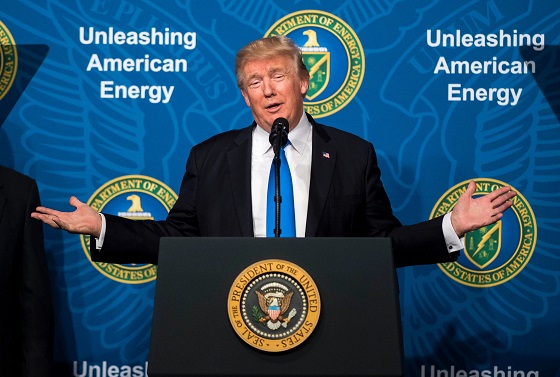Uncategorized
Trump’s ‘Drill, Baby, Drill’ Agenda Will Likely Take On An Entirely New Shape
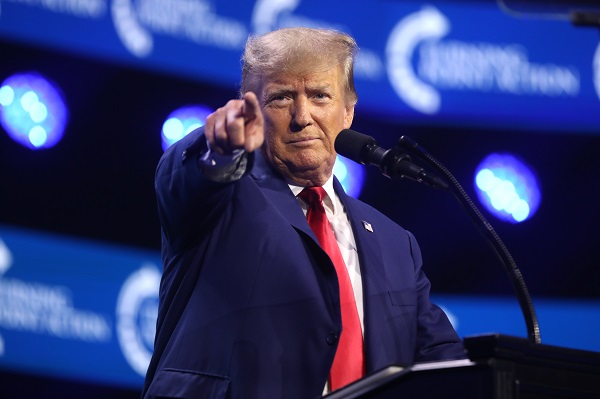

From the Daily Caller News Foundation
By David Blackmon
During his campaign and since taking office, President Donald Trump often repeated his desire to bring back the same “drill, baby, drill” oil and gas agenda that characterized his first term in office.
But that term began 8 long years ago and much has changed in the domestic oil business since then. Current market realities are likely to mitigate the industry’s response to Trump’s easing of the Biden administration’s efforts to restrict its activities.
Trump’s second term begins as the upstream segment of the industry has enjoyed three years of strong profitability and overall production growth by employing a strategy of capital discipline, technology deployment and the capture of economies of scale in the nation’s big shale play areas. Companies like, say, ExxonMobil and Oxy and their peers are unlikely to respond to the easing of government regulations by discarding these strategies that have brought such financial success in favor of moving into a new drilling boom.
This bias in favor of maintenance of the status quo is especially likely given that the big shale plays in the Permian Basin, Eagle Ford Shale, Bakken Shale, Haynesville and the Marcellus/Utica region have all advanced into the long-term development phases of the natural life cycle typical of every oil and gas resource play over the past 175 years. Absent the discovery of major new shale or other types of oil-or-natural gas-bearing formations, a new drilling boom seems quite unlikely under any circumstances.
One market factor that could result in a somewhat higher active rig count would be a sudden rise in crude oil prices, if it appears likely to last for a long period of time. Companies like Exxon, Chevron, Oxy and Diamondback Energy certainly have the capability to quickly activate a significant number of additional rigs to take advantage of long-term higher prices.
But crude prices are set on a global market, and that market has appeared over-supplied in recent months with little reason to believe the supply/demand equation will change significantly in the near future. Indeed, the OPEC+ cartel has been forced to postpone planned production increases several times over the past 12 months as an over-supplied market has caused prices to hover well below the group’s target price.
But it is wrong to think the domestic oil industry will not respond in any way to Trump’s efforts to remove Biden’s artificial roadblocks to energy progress. Trump’s efforts to speed up permitting for energy projects of all kinds are likely to result in a significant build-out of much-needed new natural gas pipeline capacity, natural gas power generation plants and new LNG export terminals and supporting infrastructure.
Instead of another four years of “drill, baby, drill,” the Trump efforts to speed energy development seem certain to result in four years of a “build, baby, build” boom.
Indeed, the industry is already responding in a big way in the LNG export sector of the business. During Trump’s first week in office, LNG exporter Venture Global launched what is the largest energy IPO by value in U.S. history, going public with a total market cap of $65 billion.
With five separate export projects currently in various stages of development, all in South Louisiana, Venture Global plans to become a major player in one of America’s major growth industries in the coming years. Trump’s Day 1 reversal of Biden’s senseless permitting pause on LNG infrastructure is likely to kick of a number of additional LNG projects by other operators.
The Trump effect took hold even before he took office when the Alaska Gasline Development Corporation entered into an exclusive agreement in early January with developer Glenfarne to advance the $44 billion Alaska LNG project. The aim is to start to deliver gas in 2031, with LNG exports following shortly thereafter.
America’s oil and gas industry has demonstrated it can consistently grow overall production to new records even with a falling rig count in recent years. Now it must grow its related infrastructure to account for the rising production.
That’s why Trump’s “drill, baby, drill” mantra is likely to transform into “build, baby, build” in the months and years to come.
David Blackmon is an energy writer and consultant based in Texas. He spent 40 years in the oil and gas business, where he specialized in public policy and communications.
Uncategorized
New report warns WHO health rules erode Canada’s democracy and Charter rights
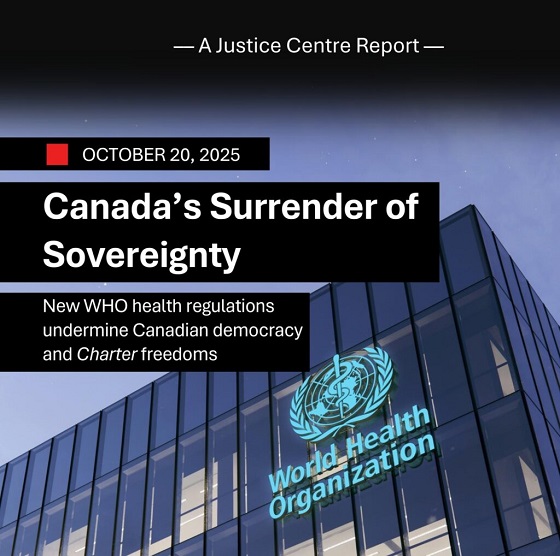
The Justice Centre for Constitutional Freedoms has released a new report titled Canada’s Surrender of Sovereignty: New WHO health regulations undermine Canadian democracy and Charter freedoms. Authored by Nigel Hannaford, a veteran journalist and researcher, the report warns that Canada’s acceptance of the World Health Organization’s (WHO) revised International Health Regulations (IHR) represents a serious erosion of national independence and democratic accountability.
The IHR amendments, which took effect on September 19, 2025, authorize the WHO Director-General to declare global “health emergencies” that could require Canada to follow directives from bureaucrats in Geneva, bypassing the House of Commons and the will of Canadian voters.
The WHO regards these regulations as “binding,” despite having no ability or legal authority to impose such regulations. Even so, Canada is opting to accept the regulations as binding.
By accepting the WHO’s revised IHR, the report explains, Canada has relinquished its own control over future health crises and instead has agreed to let the WHO determine when a “pandemic emergency” exists and what Canada must do to respond to it, after which Canada must report back to the WHO.
In fact, under these International Health Regulations, the WHO could demand countries like Canada impose stringent freedom-violating health policies, such as lockdowns, vaccine mandates, or travel restrictions without debate, evidence review, or public accountability, the report explains.
Once the WHO declares a “Pandemic Emergency,” member states are obligated to implement such emergency measures “without delay” for a minimum of three months.
Importantly, following these WHO directives would undermine government accountability as politicians may hide behind international “commitments” to justify their actions as “simply following international rules,” the report warns.
Canada should instead withdraw from the revised IHR, following the example of countries like Germany, Austria, Italy, Czech Republic, and the United States. The report recommends continued international cooperation without surrendering control over domestic health policies.
Constitutional lawyer Allison Pejovic said, “[b]y treating WHO edicts as binding, the federal government has effectively placed Canadian sovereignty on loan to an unelected international body.”
“Such directives, if enforced, would likely violate Canadians’ Charter rights and freedoms,” she added.
Mr. Hannaford agreed, saying, “Canada’s health policies must be made in Canada. No free and democratic nation should outsource its emergency powers to unelected bureaucrats in Geneva.”
The Justice Centre urges Canadians to contact their Members of Parliament and demand they support withdrawing from the revised IHR to restore Canadian sovereignty and reject blind compliance with WHO directives.
Uncategorized
CNN’s Shock Climate Polling Data Reinforces Trump’s Energy Agenda


From the Daily Caller News Foundation
As the Trump administration and Republican-controlled Congress move aggressively to roll back the climate alarm-driven energy policies of the Biden presidency, proponents of climate change theory have ramped up their scare tactics in hopes of shifting public opinion in their favor.
But CNN’s energetic polling analyst, the irrepressible Harry Enten, says those tactics aren’t working. Indeed, Enten points out the climate alarm messaging which has permeated every nook and cranny of American society for at least 25 years now has failed to move the public opinion needle even a smidgen since 2000.
Appearing on the cable channel’s “CNN News Central” program with host John Berman Thursday, Enten cited polling data showing that just 40% of U.S. citizens are “afraid” of climate change. That is the same percentage who gave a similar answer in 2000.
Dear Readers:
As a nonprofit, we are dependent on the generosity of our readers.
Please consider making a small donation of any amount here.
Thank you!
Enten’s own report is an example of this fealty. Saying the findings “kind of boggles the mind,” Enten emphasized the fact that, despite all the media hysteria that takes place in the wake of any weather disaster or wildfire, an even lower percentage of Americans are concerned such events might impact them personally.
“In 2006, it was 38%,” Enten says of the percentage who are even “sometimes worried” about being hit by a natural disaster, and adds, “Look at where we are now in 2025. It’s 32%, 38% to 32%. The number’s actually gone down.”
In terms of all adults who worry that a major disaster might hit their own hometown, Enten notes that just 17% admit to such a concern. Even among Democrats, whose party has been the major proponent of climate alarm theory in the U.S., the percentage is a paltry 27%.
While Enten and Berman both appear to be shocked by these findings, they really aren’t surprising. Enten himself notes that climate concerns have never been a driving issue in electoral politics in his conclusion, when Berman points out, “People might think it’s an issue, but clearly not a driving issue when people go to the polls.”
“That’s exactly right,” Enten says, adding, “They may worry about in the abstract, but when it comes to their own lives, they don’t worry.”
This reality of public opinion is a major reason why President Donald Trump and his key cabinet officials have felt free to mount their aggressive push to end any remaining notion that a government-subsidized ‘energy transition’ from oil, gas, and coal to renewables and electric vehicles is happening in the U.S. It is also a big reason why congressional Republicans included language in the One Big Beautiful Bill Act to phase out subsidies for those alternative energy technologies.
It is key to understand that the administration’s reprioritization of energy and climate policies goes well beyond just rolling back the Biden policies. EPA Administrator Lee Zeldin is working on plans to revoke the 2010 endangerment finding related to greenhouse gases which served as the foundation for most of the Obama climate agenda as well.
If that plan can survive the inevitable court challenges, then Trump’s ambitions will only accelerate. Last year’s elimination of the Chevron Deference by the Supreme Court increases the chances of that happening. Ultimately, by the end of 2028, it will be almost as if the Obama and Biden presidencies never happened.
The reality here is that, with such a low percentage of voters expressing concerns about any of this, Trump and congressional Republicans will pay little or no political price for moving in this direction. Thus, unless the polls change radically, the policy direction will remain the same.
David Blackmon is an energy writer and consultant based in Texas. He spent 40 years in the oil and gas business, where he specialized in public policy and communications.
-
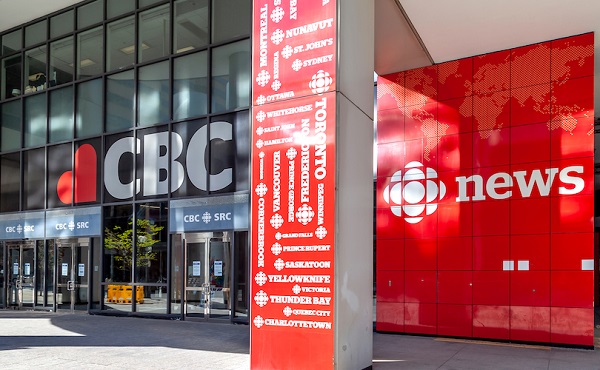
 Business20 hours ago
Business20 hours agoCBC cashes in on Carney as the news industry playing field tilts further in its favour, crippling the competition
-

 Energy2 days ago
Energy2 days agoThawing the freeze on oil and gas development in Treaty 8 territory
-

 Business2 days ago
Business2 days agoWhat Pelosi “earned” after 37 years in power will shock you
-

 Agriculture12 hours ago
Agriculture12 hours agoFarmers Take The Hit While Biofuel Companies Cash In
-

 Business2 days ago
Business2 days agoOttawa should stop using misleading debt measure to justify deficits
-
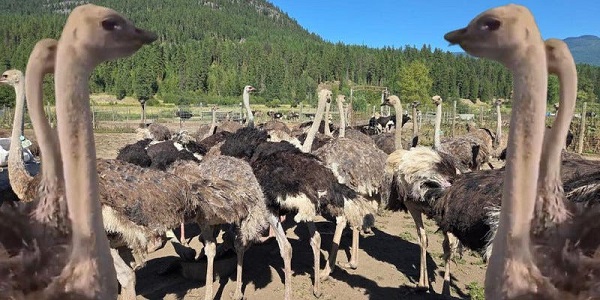
 Agriculture21 hours ago
Agriculture21 hours agoThe Canadian Food Inspection Agency’s Bloodlust for Ostriches: Part 2
-

 International2 days ago
International2 days agoBBC uses ‘neutrality’ excuse to rebuke newscaster who objected to gender ideology
-

 International2 days ago
International2 days agoLarge US naval presence in Caribbean reveals increased interest in western security


